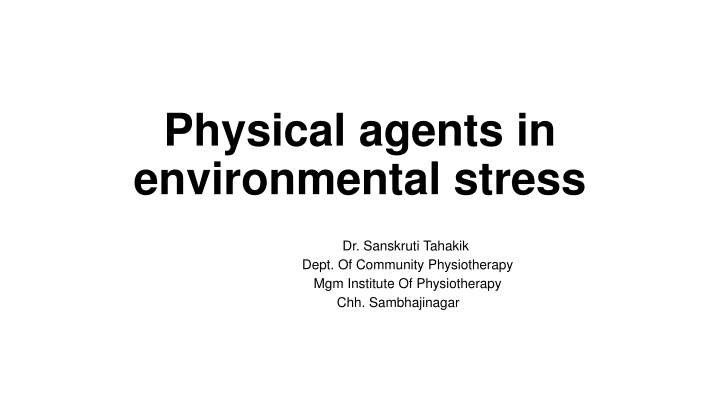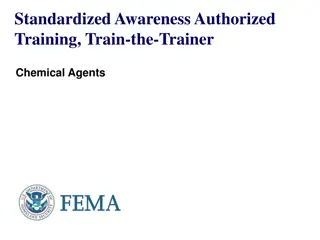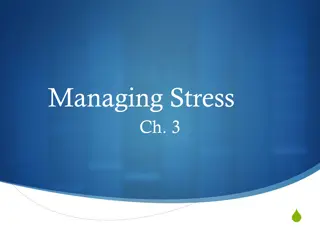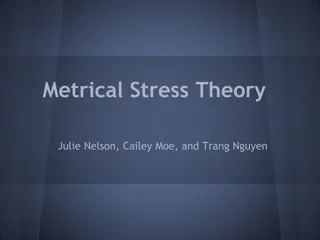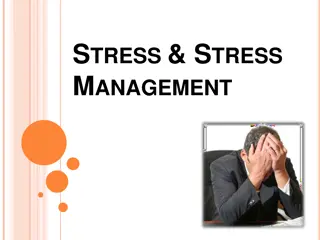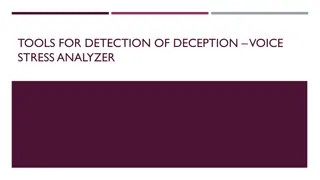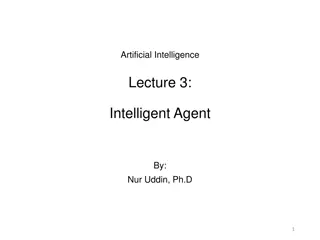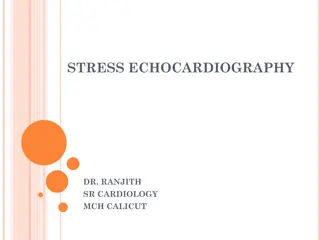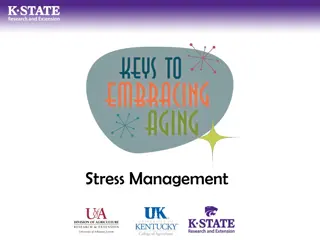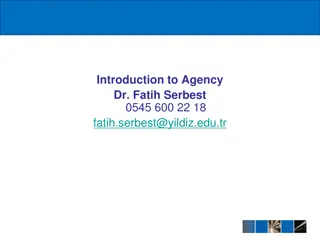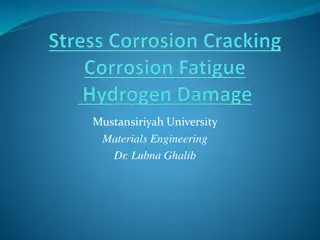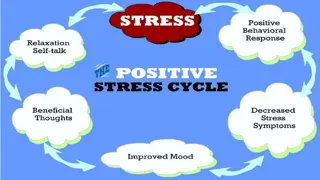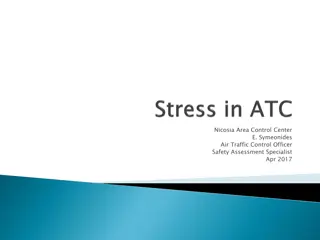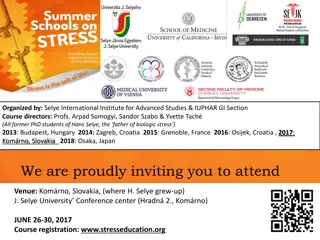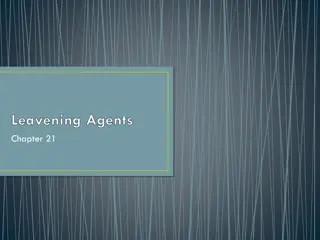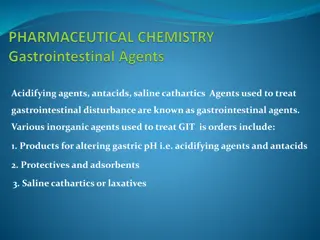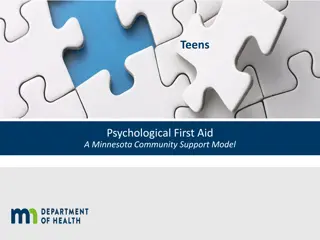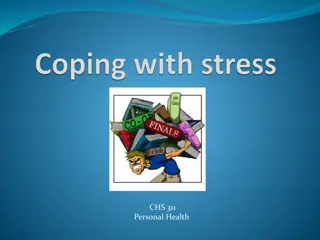Physical agents in environmental stress
"Exploring the impact of physical agents on environmental stress in the realm of physiotherapy as studied by Dr. Sanskruti Tahakik from the Department of Community Physiotherapy at MGM Institute of Physiotherapy in Chh. Sambhajinagar. The research delves into understanding the effects of various environmental stressors on the human body and strategies to mitigate their impact through physiotherapy interventions."
Uploaded on Mar 08, 2025 | 2 Views
Download Presentation

Please find below an Image/Link to download the presentation.
The content on the website is provided AS IS for your information and personal use only. It may not be sold, licensed, or shared on other websites without obtaining consent from the author.If you encounter any issues during the download, it is possible that the publisher has removed the file from their server.
You are allowed to download the files provided on this website for personal or commercial use, subject to the condition that they are used lawfully. All files are the property of their respective owners.
The content on the website is provided AS IS for your information and personal use only. It may not be sold, licensed, or shared on other websites without obtaining consent from the author.
E N D
Presentation Transcript
Physical agents in environmental stress Dr. Sanskruti Tahakik Dept. Of Community Physiotherapy Mgm Institute Of Physiotherapy Chh. Sambhajinagar
Objectives Students Should able to understand what are the Physical agents in environmental stress.
Physical agents are sources of energy that may cause injury or diseases. 1. Noise 2. Vibration 3. Radiation 4. Temperature 5. Lighting 6. Pressure
Noise is probably the most frequent physical hazard, present in the working environment as well as in our everyday life. Acute effects include hearing impairment (auditory fatigue, tinnitus), acoustic trauma which can lead to total deafness. Chronic effects including Noise induced hearing loss develop slowly and insidiously. The period of exposure is between months and years.
Non-auditory effects can be: - sleep disturbances, such are: difficulty of falling asleep, modifications of the sleep phases, decreasing of the profound sleep duration. These can affect the psycho-metric performances, can cause fatigue and can affect the mood of the person.
Vibration is the mechanical oscillations of an object about an equilibrium point. Vibration enters the body from the organ in contact with vibrating equipment.
the hand-arm vibration exposure when a worker operates hand- held equipment such as a chain saw or jackhammer, vibration affects hands and arms. the whole-body vibration exposure when a worker sits or stands on a vibrating floor or seat, the vibration exposure affects almost the entire body.
We can find vibrations in: mining, in construction, in forestry work, car driving (tractor, excavator, and bulldozer), helicopter, etc. Sources of vibrations are: the pneumatic tools, chain saw and other vibrating tools.
loss of grip strength, tingling and loss of sensation in the fingers, loss of light touch Carpal tunnel syndrome, consequence of the compression of the median nerve through the oedema caused by the initial peripheral vasodilatation which occurs in case of vibration exposure.
Technical measures imply reducing the intensity of the vibrations, the exposure time, replacing or modification of the tools and the technological processes respecting the ergonomic rules, the use of special gloves, avoiding cold exposure.
Radiation is a complex process through which the energy emitted by a source is transmitted through different media and then absorbed by a support. According to the ionizing capacity of the matter we have ionizing and non-ionizing radiation.
Stochastic Health Effects are associated with long-term, low-level (chronic) exposure to radiation. ("Stochastic" refers to the likelihood that something will happen.) Increased levels of exposure make these health effects more likely to occur, but do not influence the type or severity of the effect. Ex: cancer, mutations (teratogens or genetic effects). Non-Stochastic Health Effects appear in cases of exposure to high levels of radiation, and become more severe as the exposure increases. Short-term, high-level exposure is referred to as 'acute' exposure (burns and radiation sickness).
Technical measures: There are three important rules when ionizing radiation exposure is involved: screening of the source of radiation, increasing the distance between the source of radiation and the people exposed, reducing the time of exposure.
Non-ionizing radiation include: electro-magnetic fields, Infrared, ultraviolet (UV), visual radiation laser, microwave. Figure : EM spectrum In UV exposure effects at the eye can be: photo-kerato- conjunctivitis, cataract, retinal lesions, and malignant lesions. At the level of the skin we can have burning lesions as acute effects and premature aging and skin cancers in chronic exposure. Proper clothing, special eye protection
Lighting is an essential aspect for any workplace. Light or visible light is electromagnetic radiation that is visible to the human eye, and is responsible for the sense of sight. It is necessary to have a uniform illumination over the entire workplace by combining both, natural and artificial lighting. Visual capacity and visual comfort are very important, because many accidents are due to lighting deficiencies
Temperature Very cold and very hot temperatures can be dangerous to health. The clinic effects of cold exposure could be: local (frostbite) and systemic (hypothermia). Frostbite is a common injury caused by exposure to extreme cold or by contact with extremely cold objects Hypothermia is the most severe cold injury which occurs from excessive loss of body heat and the consequent lowering of the internal temperature of the body. Hypothermia can be fatal.
The risk of cold injury can be minimized by proper equipment design, safe work practices and appropriate clothing.
Hot Environment In outdoor occupations, such as construction, road repair, open-pit mining and agriculture, summer sunshine is the main source of heat. Indoor occupations such as: foundries, steel mills, bakeries, smelters, glass factories, and furnaces, extremely hot or molten material is the main source of heat; in laundries, restaurant kitchens, and canneries, high humidity adds to the heat burden.
Heat stroke and hyperpyrexia (elevated body temperature) are the most serious types of heat illnesses. Signs of heat stroke include body temperature often greater than 41 C, and complete or partial loss of consciousness. Heat stroke and heat hyperpyrexia require immediate first aid and medical survey. Delayed treatment may result in damage to the brain, kidneys and heart
The activities performed in conditions of abnormal pressure are grouped into two categories: activities performed at hyperbaric (atmosphere compression or decompression) and activities performed at hypobaric (pressure below that of ground level atmospheric pressure).
Workplaces with hyperbaric : underwater activities, scuba divers (the pressure exceeds with at least 0.1 atmospheres, the normal value). Workplaces with hypobaric: pilots, lift workers, modern fire protection systems in store-rooms working by reduction of the oxygen content of the air down to 13 % of oxygen.
Hyperbaric. The appearance and the evolution of the pathological aspects are based on mechanical, biochemical and biophysical effects. From the clinical point of view: 1.the trauma of the ear, and the sinus during compression period 2.the toxic effect of nitrogen and CO2 while working in increased pressure 3.caisson disease while decompression period The treatment of the acute forms is very important being considered a medical emergency, consisting of oxygen administration and modifying the pressure.
Hypobaric. The problems that occur while working in decreased pressure depend on how quick is the transfer from normal pressure to decreased pressure, how trained the person is if it gets adapted to the pressure conditions. The organs most susceptible are the middle ear and sinuses. From the clinical point of view we have: - the decompression disease at high altitude (pilots, aircraft personnel).
Hyperbaric. proper pre-employment and periodical examinations, paying a special attention to the ENT (ear-nose-throat) examination, ophthalmological, neurological and cardiac examinations. Age>45, alcoholic persons, people suffering from, cardiac or respiratory diseases are not allowed to work in such conditions. Hypobaric. Technical measures The problem was solved because of the pressurization of the planes. For mountain climbers, it is recommended climbing in stages.
Summary For a good evaluation of the workplaces and workers health condition it is necessary to have a good knowledge of the exposure at physical hazards, most of them being present in any workplace. This implies a risk assessment, measurement of the risk, comparing the level of the hazards with the threshold values, knowing the health effects, the preventive measurements, both technical and medical, the treatment, recognition and prevention of occupational diseases and occupational related diseases.
Chemical Agents in Environmental stress
A hazard is anything with the potential to cause bodily injury, and includes any physical, chemical, biological, mechanical, electrical, or ergonomic hazard. Chemicals can enter the human body via inhalation, ingestion, or dermal contact. Inhalational and dermal exposure represent the main pathways of exposure to hazardous substances at work.
Health effects Toxic chemicals can cause either local or more generalized systemic health effects. Local effects occur at the site of bodily contact, such as skin or eye irritation. Systemic effects occur at a site distant from the route of entry of the chemicals, such as liver or kidney damage.
Mechanisms of toxic effects There are various ways in which chemicals can cause harm or disease in humans. Irritants (e.g., isopropyl alcohol, acetone) produce reversible inflammatory change Sensitizers are chemicals capable of producing an allergic response. Carcinogens are chemicals capable of causing cancers in humans. A list of carcinogens has been prepared by the International Agency for Research on Cancer (IARC) of the World Health Organization (WHO).
Teratogens are chemicals that cause birth defects, abnormalities, developmental delays, or foetal death, but cause no damage to the mother. Methyl mercury, lead, and xylene are some examples of chemical teratogens. The developing foetus at the two- to eight-week stage is at highest risk.
Contact dermatitis is the most common type of occupational skin disease. It refers to an inflammation of the skin due to exposure to a hazardous agent. There are two main subtypes irritant contact dermatitis (ICD) and allergic contact dermatitis (ACD).
Summary Chemicals can be beneficial or harmful to us depending on how they are used. As with any other occupational disease, illness due to exposure to chemical hazards can be preventable. Control measures, especially primary preventive measures, should be implemented to protect the health and safety of workers and prevent unwanted effects from exposure to the chemicals.
Reference Occupational health A manual for primary health care workers world health organization.
